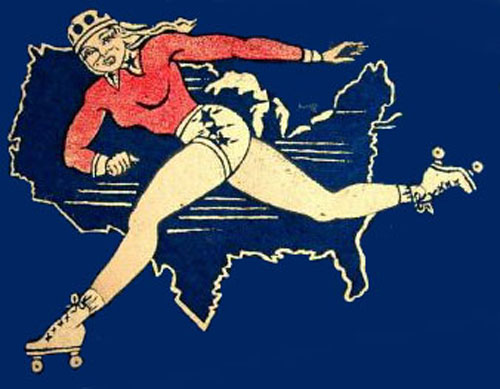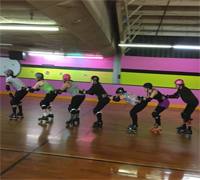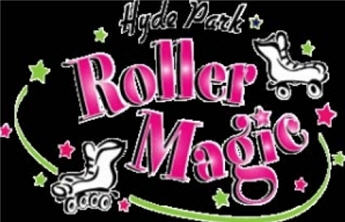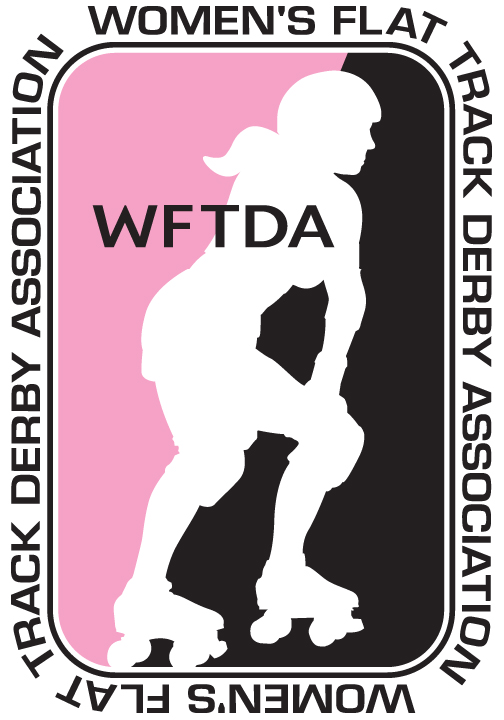What is Roller Derby?
Roller Derby is A Sport: This Game is No Joke
Here are the Rules…
The following types of blocks are illegal:
- Pushing/Shoving/Grabbing with Hands
- Intentional Tripping or Falling
- Striking with the Forearms
- Blocks to the Back
- Blocking Out of Bounds
- Blocks to the Head
- Blocking 20 feet from the pack
- Blocking Above the Shoulder
- Elbowing in an Upwards or Downwards Motion
- Punching
Derbypedia…
Team: There are 14 players on a team with 5 players on the track during a jam, 1 Pivot, 3 Blockers, and 1 Jammer
Periods: A game consists of two 30 minute periods.
Jam: Two minutes of play. The periods are divided up into jams. There is no limit to the number of jams you can have in a period. The clock does not stop between jams.
Pack: Two teams of 3 Blockers, and 1 Pivot – 4 players from each team for a total of 8 players makes up the pack.
Formation: Pivots in the front, blockers in the center of the pack, jammers line up 33 feet from the pack.
Jammers: Wears the star on her helmet. These girls are speed freaks. They make their way through the pack and score points by passing their opponents in-bounds, while trying to obtain lead jammer position.
Lead Jammer: The first jammer to break through the pack legally (without penalties and without going out of bounds) has the advantage of being able to call of the jam at any time. They do this by putting their hands on their hips.
Pivots: Wears the stripe on her helmet. They set the pace of the pack and are responsible for calling out plays. They are also the last line of defense for the opposing teams jammers. Pivots can take over as a jammer. This sneak attack maneuver is called “Passing the Star”.
Blockers: They are the brains and brawn of the pack. The must play offensively by working together to block the opposing teams jammer and defensively by assisting their own jammer.
The Game…
The first whistle will blow to start the pack. Once the last blocker crosses the starting line, the second whistle signals for the jammers to begin.
On their first trip through the pack, the jammers do not score points – they are instead fighting for lead jammer position. That means they must be the first to break through the pack without getting knocked out of bounds and without getting any penalties. The lead jammer referee will signal who is lead jammer by making an “L” formation with their arms, pointing at the jammer with lead jammer status. The lead jammer has the advantage of being able to call of the jam at any time. If no one qualifies for lead jammer, the refs will cross their arms back and forth in front of them to signal no lead and the jam will run the full 2 minutes.
Once the jammers have lapped the pack once, they can now score points for each opposing blocker they pass in bounds and without getting a penalty on. Passing the blockers hips is considered a full pass.
It is not easy though – opposing teams blockers will be impeding their way through the pack while her own teammates will be trying the clear a path for the jammer and assisting her with whips, pushes, and pulls.
A Brief History…
In 1929 as the great depression began, a film publicist named Leo A. Seltzer decided to combine the idea of dance marathons with the growing phenomenon of roller skating, creating the first ever Transcontinental Roller Derby. Teams of two people had to cover 3,000 miles in one month – the distance between Los Angeles and New York City. The show was taken on the road, and when teams would accidentally get tangled up or collisions would occur on the track, the crowd would go wild. The spectacle evolved into a sport with teams of 5 players and rules for the game. Roller Derby is one of the few truly American sports, and it was the first sport to be fully integrated, well before it became the acceptable norm.
Roller Derby boomed in the 1950’s, mostly in part because of the ability to reach a large audience by televised games. Then in 1975 roller derby all but disappeared. There were attempts at resurgences in the 1980’s and 1990’s but it wasn’t until 2000, that the roller derby revival really began… and here we are today.



